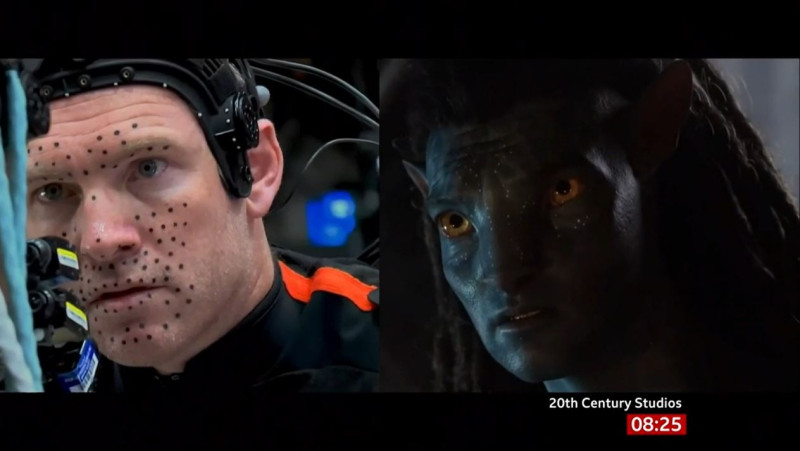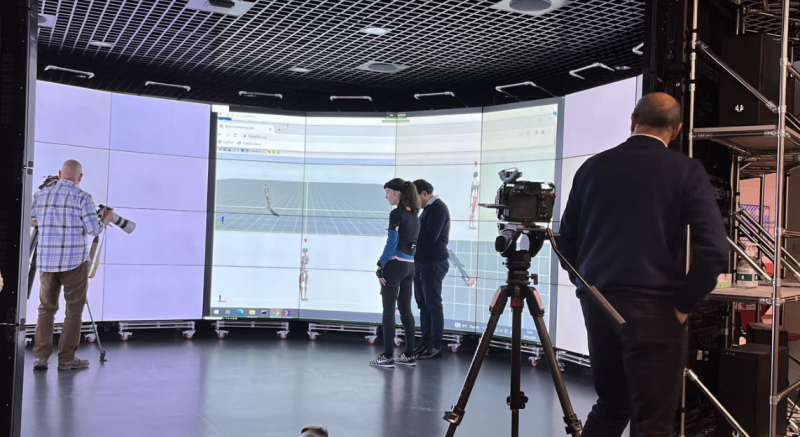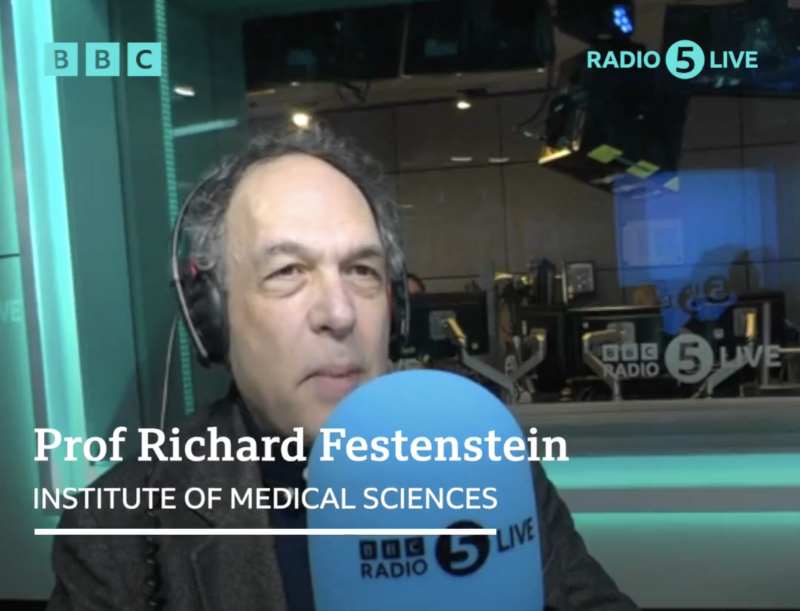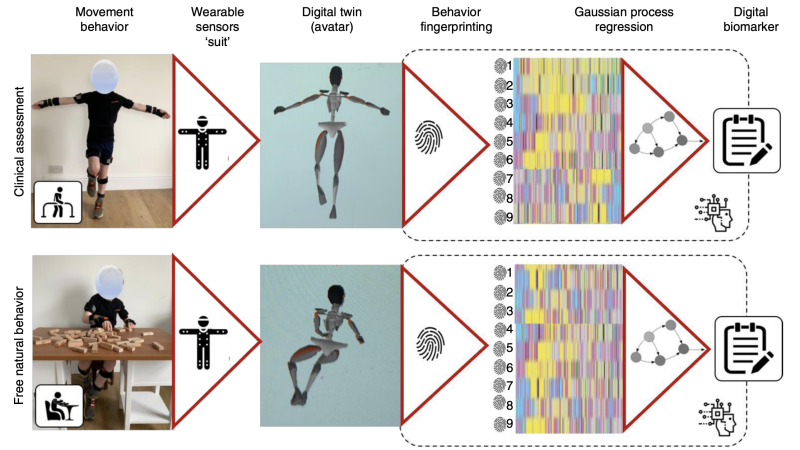By Sofia Velazquez Pimentel

Artificial intelligence (AI) researchers and doctors at Imperial College London, MRC Laboratory of Medical Sciences (MRC LMS), UCL, UCLH and Great Ormond Street Hospital, have developed a way to monitor the progression of movement disorders using motion capture technology and AI. This research was broadcasted by BBC One, BBC Breakfast and BBC Radio 5 Live and highlighted the ground-breaking potential of wearable AI to develop drugs for rare movement diseases quickly and cheaply.
In two ground-breaking studies, published in Nature Medicine, scientists have shown that by combining data gathered from wearable tech with a powerful new medical AI technology they can identify clear movement patterns, predict future disease progression and significantly increase the efficiency of clinical trial monitoring in two rare disorders, Duchenne muscular dystrophy (DMD) and Friedreich’s ataxia (FA).
FA and DMD are rare, degenerative, genetic diseases that affect movement and eventually lead to paralysis. There are currently no cures for either disease, but researchers hope that these results will significantly speed up the search for new treatments.
Professor Richard Festenstein a neurogeneticist from the MRC LMS at Imperial College London, Department of Brain Sciences and Honorary Consultant in Neurogenetics at Imperial College Healthcare NHS Trust and the National Hospital for Neurology and Neurosurgery (UCLH) met Professor Aldo Faisal from Imperial College London’s Department of Bioengineering and Computing at a dinner to celebrate the 105th anniversary of the Medical Research Council. They realised the potential of bringing together the technology of motion capture suits, (such as those used in Hollywood feature films like Avatar) and machine learning to work with patients with neurodegenerative diseases. In collaboration with the NIHR Great Ormond St and UCL hospital, they embarked on trials of the technology in patients with FA and DMD.

Behind the scenes: Yanita Oparlaova, a person with Friedreich’s Ataxia, walks with the wearable AI which has produced a digital twin (shown on the screen behind her) which mirrors her movements.
Patients wearing the mocap suits were able to have their movements analysed and this data was used to predict the progression of disorders. One of the advantages of this is that fewer patients are required to carry out highly powered clinical trials, which makes a great difference in the ability of scientists to carry out trials, particularly in rare disorders such as FA and DMD.
“Patients and families often want to know how their disease is progressing, and motion capture technology combined with AI could help to provide this information. We’re hoping that this research has the potential to transform clinical trials in rare movement disorders, as well as improve diagnosis and monitoring for patients above human performance levels.”
Professor Richard Festenstein from the Department of Brain Sciences and MRC LMS at Imperial College London, and Honorary Consultant in Neurogenetics at Imperial College Healthcare NHS Trust and the National Hospital for Neurology and Neurosurgery (UCLH) and Co-author of both studies.

MRC LMS Professor Richard Festenstein Senior Researcher on both studies on BBC Radio 5 Live
Professor Aldo Faisal, of Imperial College London’s Departments of Bioengineering and Computing and Senior author of both papers said: “This approach gathers huge amounts of data on a person’s full-body movement – more than any neurologist will have time to observe a patient. Our AI technology builds a digital twin of human motion behaviour and allows us to make unprecedented, precise predictions of how an individual patient’s disease will progress. We now have a way to detect subtle changes in movement that can be applied to many diseases and help us to develop treatments for even rare diseases faster and more precisely.”
The researchers estimate that using these disease markers means that only half the number of subjects would be required for phase 2 clinical trials when compared to current methods. This is particularly important for rare diseases where it can be hard to identify suitable patients.
Scientists hope that as well as using the technology to monitor patients in clinical trials, it could also one day be used to monitor or diagnose a range of diseases that affect movement behaviour such as dementia, strokes, and orthopaedic conditions.
“Researching rare conditions can be substantially more costly and logistically challenging, which means that patients are missing out on potential new treatments. Increasing the efficiency of clinical trials gives us hope that we can test many more treatments successfully.”
Dr Valeria Ricotti, honorary clinical lecturer at the UCL GOS ICH and first author on the DMD study and co-author on the FA study
Using Wearable Technology to Identify Movement fingerprints
In the DMD-focused study, researchers and clinicians at Great Ormond Street Hospital trialled the body-worn sensor suit in 21 children with DMD and 17 healthy age-matched controls. The children wore the sensors while carrying out standard clinical assessments (like the 6-minute walk test) as well as during regular everyday activities like having lunch or playing.

Researchers created a digital twin for young patients with DMD to create a movement fingerprint during clinical assessments and everyday activities such as playing.
All the data from the sensors were collected and fed into AI technology to create individual avatars and analyse movements. This vast data set and powerful computing tool, combined with the specialist clinical expertise of the team allowed researchers to define key movement fingerprints seen in children with DMD that were not seen in the control group. Many of these movement patterns had not been described clinically before.
Scientists also discovered that the new AI technique could also significantly improve predictions of how individual patients’ disease would progress over six months compared to current gold-standard assessments. Such a precise prediction allows to run clinical trials more efficiently so that patients can access novel therapies quicker, and help dose drugs more precisely.
“Just like our fingers leave unique patterns by which a computer can identify us, we developed a method that recognises movement patterns that recognise the progression of disease. Crucially the same AI technology can distinguish movement patterns of the two very different diseases from the huge variety of normal body movements we perform.”
- Dr Balasundaram Kadirvelu from Imperial College London’s Departments of Bioengineering and Computing, joint-first author of both papers.
In the FA study, as well as identifying key movement patterns, the AI technology was able to predict genetic markers of disease. FA is caused by an unusually large triplet repeat of DNA, which switches off the FA gene. Using this new AI technology, the team were able to use movement data to accurately predict the ‘switching off’ of the FA gene, measuring how active it was without the need to take any biological samples from patients.
Tracking the progression of FA and DMD is normally done through intensive testing in a clinical setting. These papers offer a significantly less invasive option for movement measurement that also increases the accuracy and objectivity of the data collected.
The future of clinical trials
This new way of gathering specific and accurate movement measurements provides clinical teams with clear disease markers and progression predictions. These are invaluable tools during clinical trials to measure the benefits of new treatments.
The new technology could help researchers carry out clinical trials of conditions that affect movement more quickly and accurately. In the DMD study, researchers showed that this new technology could significantly reduce the number of children required for phase 2 trials. This is especially powerful when studying rare diseases when patient populations are smaller. In addition, the technology allows us to study patients across life-changing disease events such as loss of ambulation whereas current clinical trials target either ambulant or non-ambulant patient cohorts.
Watch the BBC 5 Live!
Both papers were published in Nature Medicine – the two papers ‘A wearable motion capture suit and machine learning predict disease progression in Friedreich’s ataxia‘ and ‘Wearable full-body motion tracking of activities of daily living predicts disease trajectory in Duchenne muscular dystrophy‘. This was research was done by Imperial College London, MRC Laboratory of Medical Sciences (MRC LMS), UCL, UCLH and Great Ormond Street Hospital.
The research was funded by a UKRI Turing AI Fellowship to Professor Faisal, NIHR Imperial College Biomedical Research Centre (BRC), the MRC Laboratory of Medical Sciences, the Duchenne Research Fund, the NIHR Great Ormond Street Hospital (GOSH) BRC, the UCL/UCLH BRC, and the UK Medical Research Council.
